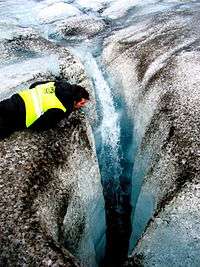Cryoconite
Cryoconite is powdery windblown dust made of a combination of small rock particles, soot and microbes[1] which is deposited and builds up on snow, glaciers, or ice caps. The darkening, especially from small amounts of soot, absorbs solar radiation melting the snow or ice beneath the deposit, and sometimes creating a cryoconite hole.[2] Cryoconite may contain dust from far away continental deserts or farmland, particles from volcanic eruptions or power plant emissions, and soot. It was first described and named by Nils A. E. Nordenskiöld when he traveled on Greenland's icecap in 1870.[3] During summer, cryoconite holes frequently contain liquid water and thus provide a niche for cold-adapted microorganisms like bacteria, algae and animals like rotifers[4] and tardigrades to thrive. Cryoconite typically settles and concentrates at the bottom of these holes creating a noticeable dark mass.

Soot decreases the reflectivity, or albedo of ice, increasing absorption of heat. Cryoconite is constantly being added to snow and ice formations along with snow. It is buried within the snow or ice, but as the snow or ice melts increasing amounts of dark material is exposed on the surface, accelerating melting.[3]
 measuring a Cryoconite hole, Longyearbreen glacier (Longyear Valley)
measuring a Cryoconite hole, Longyearbreen glacier (Longyear Valley) taking a sample, Longyearbreen glacier
taking a sample, Longyearbreen glacier
Notes
- "The darkening of Arctic glaciers". Aberystwyth University. Retrieved 1 February 2013.
- "Cryoconite hole information". Archived from the original on 2009-11-23. Retrieved 2010-07-08.
- Jenkins, M. "Changing Greenland - Melt Zone" page 3, of 4, National Geographic June 2010, accessed July 8, 2010
- Fontaneto D; Iakovenko N; De Smet W.H. (2015). "Diversity gradients of rotifer species richness in Antarctica". Hydrobiologia. 750 (1). doi:10.1007/s10750-015-2258-5. hdl:10067/1255870151162165141.
External links and further reading
| Wikimedia Commons has media related to Cryoconites. |